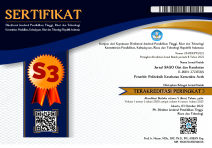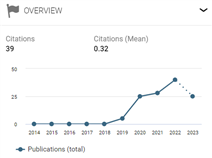Hubungan supan protein dan keragaman pangan dengan kejadian underweight pada balita usia 12-59 bulan di Kabupaten Bima
DOI: 10.30867/gikes.v6i1.2375Abstract
Background: Toddlers’ protein intake is still less than the nutritional adequacy figure, due to non-diverse eating habits. Children often have unhealthy eating habits, such as limiting food consumption to only one type of food, which can result in malnutrition.
Objectives: The aim of the research was to analyze the relationship between protein intake and food diversity with the incidence of underweight in toddlers aged 12-59 months in Bima Regency.
Methods: This study employed an analytic observational research design with a cross-sectional approach. This research was conducted in Bima regency in May-June 2024. We simultaneously sampled 101 toddlers aged 12 to 59 months at a single point in time. The assessment of protein intake and food diversity was conducted using the semi quantitative food frequency questionnaire (SQ-FFQ). The SQ-FFQ interviews generated direct scores for the individual dietary diversity score (IDDS) based on nine food groups, and underweight nutritional status was measured using a digital weighing scale. Data analized used the chi-square test and logistic regression analysis.
Results: Among the toddlers, 78,2% of those classified as underweight had insufficient protein intake, and 75,9% consumed a non-diverse diet (less than 5 types of food groups). There were significant association between protein intake and underweight status (p-value = 0,000); as well as between food diversity and underweight status (p-value = 0,001).
Conclusion: the nutritional status of toddlers aged 12-59 months in Bima Regency is significantly related to protein intake and food diversity.
Keywords
Full Text:
PDFReferences
Al Rahmad, A. H. (2019). Perbedaan status gizi balita berdasarkan karakteristik keluarga di Aceh Besar. Jurnal Kedokteran Syiah Kuala, 19(3).
Aboagye, R. G., Seidu, A.-A., Ahinkorah, B. O., Arthur-Holmes, F., Cadri, A., Dadzie, L. K., … Yaya, S. (2021). Dietary diversity and undernutrition in children aged 6–23 months in Sub-Saharan Africa. Nutrients, 13(10), 3431. https://doi: 10.3390/nu13103431.
Acquah, E., Darteh, E. K. M., Amu, H., & Adjei, D. K. A. (2019). Predictors of underweight in children under-five years in Ghana. Ghana Medical Journal, 53(1), 71–78. https://doi: 10.4314/gmj.v53i1.11.
Al Rahmad, A. H. (2019). Perbedaan status gizi balita berdasarkan karakteristik keluarga di Aceh Besar. Jurnal Kedokteran Syiah Kuala, 19(3).
Angela, I. I., Punuh, M. I., & Malonda, N. S. H. (2017). Hubungan Antara Asupan Energi Dan Protein Dengan Status Gizi Anak Balita Di Wilayah Kerja Puskesmas Kombos Kota Manado. KESMAS: Jurnal Kesehatan Masyarakat Universitas Sam Ratulangi, 6(2), 45-52.
Anggraeni, L. D., Toby, Y. R., & Rasmada, S. (2021). Analisis Asupan Zat Gizi Terhadap Status Gizi Balita. Faletehan Health Journal, 8(2), 92–101. www.journal.Ippm-stikesfa.ac.id/ojs/index.php/FHJ
Chege, P. M., & Kuria, E. N. (2017). Relationship between nutrition knowledge of caregivers and dietary practices of children under five in Kajiado County, Kenya. Journal Women’s Health Bulletin, 4(3), 1–5. https://doi.org/10.5812/whb.43820
Fathurrahman, F., Nurhamidi, N., & Aprianti, A. (2021). Faktor Underweight Pada Balita Di Daerah Bantaran Sungai Martapura Kabupaten Banjar. Dinamika Kesehatan: Jurnal Kebidanan Dan Keperawatan, 12(2), 559–571. https://doi.org/10.33859/dksm.v12i2.763
Handriyanti, R. F., & Fitriani, A. (2021). Analisis keragaman pangan yang dikonsumsi balita terhadap risiko terjadinya stunting di indonesia. Muhammadiyah Journal of Nutrition and Food Science (MJNF), 2(1), 32–42. https://doi.org/1024853/mjnf.
Irawan, I. R. (2021). Risk factors for underweight among children aged 6-59 Months in Indonesia. In The International Conference on Public Health Proceeding (Vol. 6, pp. 772–785). https://doi.org/1026911/ICPHmaternal.FP.
Kamila, L. N., Hidayanti, L., & Atmadja, T. F. A.-G. (2022). Keragaman pangan dengan kejadian kurang gizi pada anak usia 6-23 bulan. Nutrition Scientific Journal, 1(1), 1–7. https://doi.org/10.37058/nsj.v1i1.5704.
Khan, S., Zaheer, S., & Safdar, N. F. (2019). Determinants of stunting, underweight and wasting among children< 5 years of age: evidence from 2012-2013 Pakistan demographic and health survey. BMC Public Health, 19, 1–15. https://doi:10.1186/s12889-019-6688-2.
Mahmudiono, T., Mamun, A. Al, Nindya, T. S., Andrias, D. R., Megatsari, H., & Rosenkranz, R. R. (2018). The effectiveness of nutrition education for overweight/obese mother with stunted children (NEO-MOM) in reducing the double burden of malnutrition. Nutrients, 10(12), 1910. https://doi:103390/nu10121910.
Modjadji, P., Molokwane, D., & Ukegbu, P. O. (2020). Dietary diversity and nutritional status of preschool children in North West Province, South Africa: a cross sectional study. Children, 7(10), 174. https://doi.10.3390/children7100174.
Molani-Gol, R., Kheirouri, S., & Alizadeh, M. (2023). Does the high dietary diversity score predict dietary micronutrients adequacy in children under 5 years old? A systematic review. Journal of Health, Population and Nutrition, 42(1), 2. https://doi.10.1186/s41043-022-00337-3.
Ocampo-Guirindola, M. L., Garcia-Malabad, C. J., Valdeabella-Maniego, M. L. M., & Punzalan, S. L. M. (2016). Association between dietary diversity score and nutritional status of Filipino children aged 6-23 months. Philipp J Sci, 145(1), 57–69. https://philjournalsci.dost.gov.ph
Rahim, F. K. (2014). Faktor risiko underweight balita umur 7-59 bulan. Jurnal Kesehatan Masyarakat, 9(2), 115–121. https://doi.org/10.15294/kemas.v9i2.2838.
Rarastiti, C. N., & Syauqy, A. (2014). Hubungan karakteristik ibu, frekuensi kehadiran anak ke Posyandu, asupan energi dan protein dengan status gizi anak usia 1-2 tahun. Journal of Nutrition College, Diponegoro University. https://doi.org/10.14710/jnc.v3i1.4537
Sagaro, G. G., & Alemayehu, M. (2017). Dietary diversity and associated factors among infants and young children in Wolaita Zone, Southern Ethiopia. Sci J Clin Med, 6(4), 53. Doi: 10.11648/J.SJCM.20170604.12
Sié, A., Tapsoba, C., Dah, C., Ouermi, L., Zabre, P., Bärnighausen, T., … Moe, C. (2018). Dietary diversity and nutritional status among children in rural Burkina Faso. International Health, 10(3), 157–162. https://doi:10.1093/inthealth/ihy016
Soumokil, O. (2017). Hubungan asupan energi dan protein dengan status gizi anak balita di Kecamatan Nusalaut Kabupaten Maluku Tengah. Global Health Science, 2(4), 341–350. http://dx.doi.org/10.33846/ghs.v2i4.163
UNICEF. (2020). Nutrition, for every child: UNICEF Nutrition Strategy 2020–2030. UNICEF Publ, 1–98.
Wantina, M., Rahayu, L. S., & Yuliana, I. (2017). Keragaman konsumsi pangan sebagai faktor risiko stunting pada balita usia 6-24 bulan. Journal Uhamka, 2(2), 89–96. https://journal.uhamka.ac.id/index.php/argipa.
WHO dan UNICEF. (2021). Indicators for Assessing Infant and Young Child Feeding Practices. WHO dan UNICEF.
Refbacks
- There are currently no refbacks.














